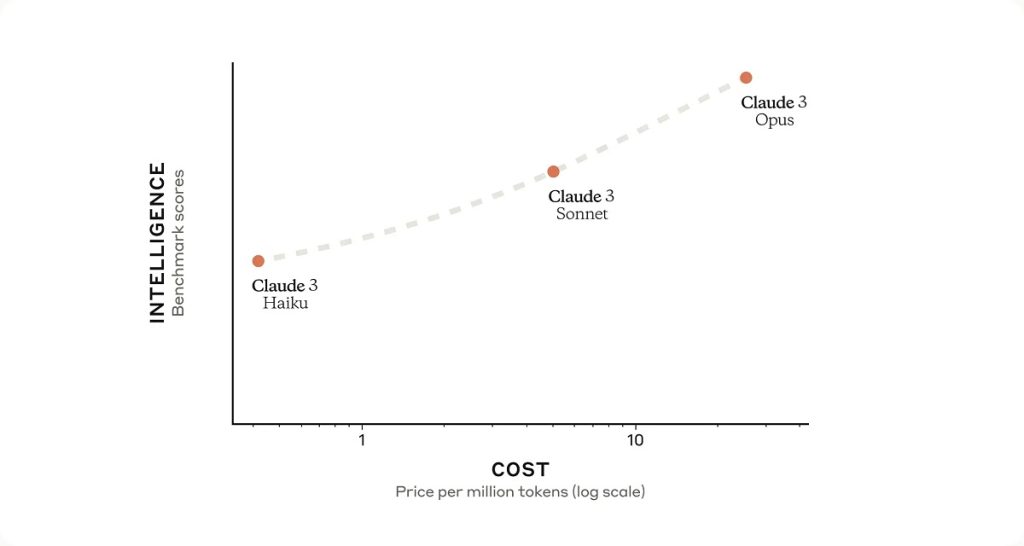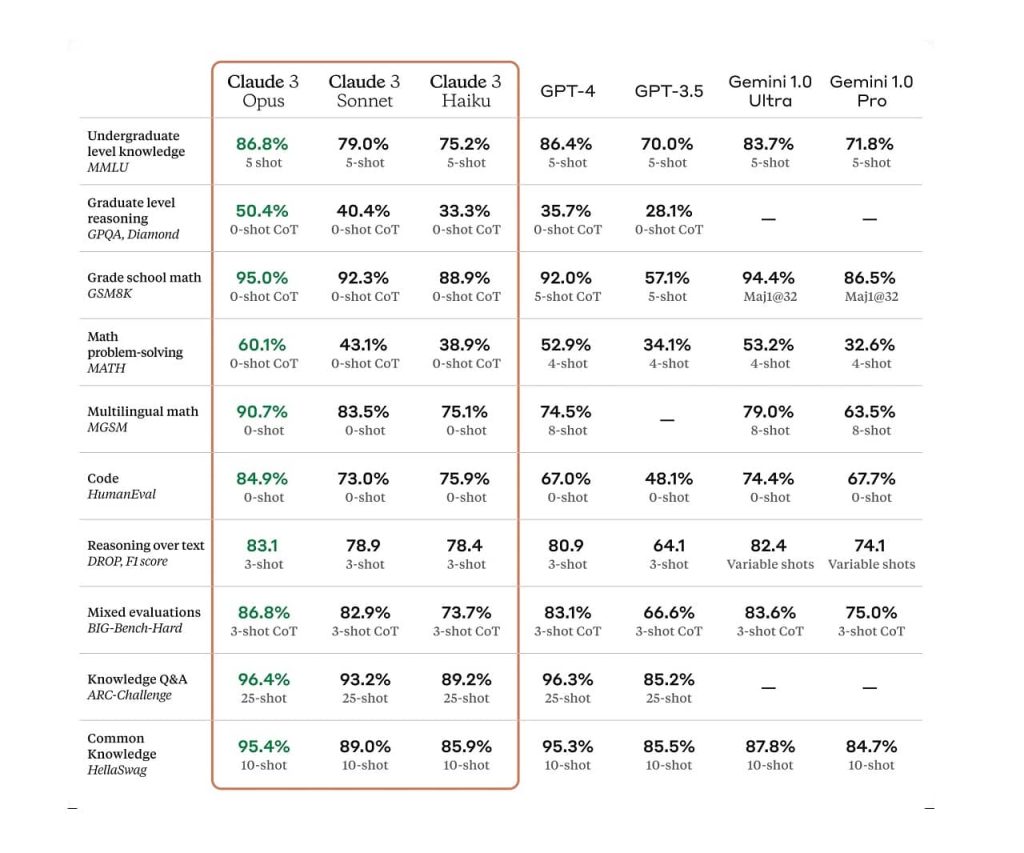Anthropic has surprised the whole world of Generative AI by announcing the release of its latest chatbot model Claude 3. Experts say it can beat ChatGPT and Gemini in some cases. How? Let’s find out.
Highlights:
- Anthropic announces Claude 3, a new chatbot and collection of AI models, claimed to be its fastest.
- Can summarise up to 150,000 words, Compared to ChatGPT which can do up to 3,000 words only.
- Comes with a contextual window rivaling Gemini Ultra 1.0 enhanced accuracy and fewer refusals.
The Claude 3 Model Family Explained
Anthrhropic has introduced Claude 3 with a family of three models namely Claude 3 Haiku, Claude 3 Sonnet, and Claude 3 Opus. Opus is the most intelligent model among the three and its benchmarks surpass several other rival AI models such as OpenAI’s ChatGPT and Google’s Gemini.
The company was founded by former members of OpenAI and even funded by Amazon and Google. Now it is challenging OpenAI’s ChatGPT and Google’s Gemini on various benchmarks.
Here is a comparison of the 3 models, via their official announcement:

The models have been released to be successive with increasingly powerful performance, benchmarks, and cost. Developers worldwide can choose any model out of the three based on their needs and application dependencies.
For beginners, here are some prompts to try in Claude 3 and find out how it can be beneficial for different industry professionals.
Outstanding Benchmarks: Surpassing ChatGPT and Gemini
All the Claude 3 models have shown Increased skills in analysis and forecasting, complex content production, code generation, and speaking non-English languages including French, Spanish, and Japanese.
Opus has outstanding benchmark numbers and surpasses GPT-4 and Gemini 1.0 Ultra in several aspects of common evaluation such as undergraduate-level expert knowledge (MMLU), graduate-level expert reasoning (GPQA), and basic mathematics (GSM8K).
Take a look at the benchmark comparison where you can see Opus beating Gemini and GTP-4 across ten grounds of evaluation and metrics:

Anthropic has just magnified the war of AI by bringing Opus to the scene. You can even compare GPT-4 and Gemini 1.5 for more details.
5 Outstanding Features of Claude 3
Claude 3 comes with several features and improved capabilities compared to its peers and also its predecessor Claude 2.1. Let’s take a look at them.
1) Instantaneous Results: Leading the Race of AI Models
In terms of price and speed, Haiku is the best model available for its intelligence category. In less than three seconds, it can read a research paper on arXiv (~10,000 tokens) that is rich with information and data and includes charts and graphs.
This is a new competition to Groq which is currently the world’s fastest AI model that comes with its GPU optimization approach for faster results. Who knows if Haiku could even surpass Groq following its launch?
Anthropic has also made a huge leap from its predecessor as with greater levels of intelligence, Sonnet is two times faster than Claude 2 and Claude 2.1 for the great majority of workloads. It is particularly good at activities requiring quick replies, such as sales automation or information retrieval.
2) Stronger Vision Capabilities over GPT-4
One of the hottest features of the World of Gen AI models has to be multimodal capabilities. Claude 3 from Anthropic lets users input photographs and other documents for analysis; it doesn’t create any images. The advanced vision capabilities of the Claude 3 models are comparable to those of other top models.
A large variety of visual representations, such as pictures, charts, graphs, and technical diagrams, can be processed by them. Nowadays most of the work done on knowledge bases is stored in different formats like PDFs, flowcharts, or presentation slides.
With these vision capabilities, Claude can perform various tasks such as extracting texts from images and even summarizing huge texts from PDFs for example research papers. Both Adobe and ChatGPT’s read-aloud can perform similar tasks but now will face competition from Claude 3.
Wow Claude 3 is really good at extracting text from an image
— Moritz Kremb (@moritzkremb) March 4, 2024
Way better and faster than GPT-4 pic.twitter.com/ucRRi03EDQ
According to Anthropic, Claude 3 can condense up to 150,00 words, or a substantial book. Only 75,000 words could be summarised in its prior edition. Large data sets can be entered by users, who can then request summaries in the format of letters, memos, or stories. In comparison, ChatGPT has a word count limit of roughly 3,000.
3) Long Context Window: Entering the battle with Google’s Gemini
Claude 3 comes with a token window count of up to 200K but it can accept input tokens even over 1 million, something which was only exclusive to Gemini as of now.
Recently Google’s Gemini Ultra 1.0 shocked the world with its enormous Contextual Window coming with a token count of over 1 million. Its enormous processing capabilities and information retrieval placed it on a pedestal. But with now Claude 3 on the scene, the battle is on.
Between Claude 3 and Gemini 1.5 Pro, the era of 1M+ token context windows is officially here. pic.twitter.com/sk6EqaJ4Nr
— Matt Shumer (@mattshumer_) March 4, 2024
Claude 3 also achieves near-perfect recall accuracy over these 200K tokens. By testing on a varied crowdsourced corpus of documents and selecting one of thirty randomly selected needle/question pairings for each prompt, the robustness of this benchmark was increased.
In several situations, Claude 3 Opus not only exceeded 99% accuracy and nearly flawless memory, but it also pointed up the evaluation’s shortcomings.
4) Fewer Refusals to Harmless Questions
Some harmless requests were ignored by earlier iterations of Claude, which the company claims “suggests a lack of contextual understanding.” When prompted to follow its safety guidelines, the new models are less likely to resist.
The Claude 3 models exhibit a more sophisticated comprehension of requests, can identify actual harm, and decline to respond to innocuous cues far less frequently.
5) Enhanced Accuracy over Complex Questions
Anthropic used a variety of complex and factual questions to test crucial weaknesses in Claude 3’s model family. On these difficult open-ended questions, Opus shows a two-fold increase in accuracy and correct responses over Claude 2.1, together with a decrease in the number of erroneous answers.

This is promising for developers worldwide as you can ask for more intricate answers to complex questions that required thorough processing before.
How Can You Access It?
You can access Claude 3’s Opus and Sonnet models via claude.ai and its API. All you have to do is sign up via email and then you will have instant access to these models. You can experience Sonnet for free in a private preview on Google Cloud’s Vertex AI Model Garden and through Amazon Bedrock as of right now.
Opus is only currently available to Claude Pro subscribers and Haiku hasn’t been released yet. So go ahead and try out the benefits of Opus and Sonnet starting today!
Conclusion
Antrhopic’s groundbreaking state-of-the-art Claude 3 model family has left the Generative AI world in a frenzy. The models come with leading benchmarks and cutting-edge technology that make them better than all previous AI giants in the market. This is a huge advancement in terms of AI chatbots and developers will now explore even more benefits as compared to before.








